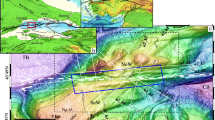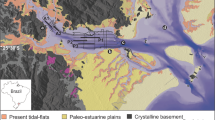Abstract
Three-dimensional (3D) seismic data acquired for hydrocarbon exploration reveal that gas accumulations are common within the 2–3 km thick Plio-Pleistocene stratigraphic column of the south-western Barents Sea continental margin. The 3D seismic data have relatively low-frequency content (<40 Hz) but, due to dense spatial sampling, long source-receiver offsets, 3D migration and advanced interpretation techniques, they provide surprisingly detailed images of inferred gas accumulations and the sedimentary environments in which they occur. The presence of gas is inferred from seismic reflection segments with anomalously high amplitude and reversed phase, compared with the seafloor reflection, so-called bright spots. Fluid migration is inferred from vertical zones of acoustic masking and acoustic pipes. The 3D seismic volume allows a spatial analysis of amplitude anomalies inferred to reflect the presence of gas and fluids. At several locations, seismic attribute maps reveal detailed images of flat spots, inferred to represent gas–water interfaces. The data indicate a focused fluid migration system, where sub-vertical faults and zones of highly fractured sediments are conduits for the migration of gas-bearing fluids in Plio-Pleistocene sediments. Gas is interpreted to appear in high-porosity fan-shaped sediment lobes, channel and delta deposits, glacigenic debris flows and sediment blocks, probably sealed by low-permeability, clayey till and/or (glacio)marine sediments. Gas and fluid flow are here attributed mainly to rapid Plio-Pleistocene sedimentation that loaded large amounts of sedimentary material over lower-density, fine-grained Eocene oozes. This probably caused pore-fluid dewatering of the high-fluid content oozes through a network of polygonal faults. The study area is suggested to have experienced cycles of fluid expulsion and hydrocarbon migration associated with glacial–interglacial cycles.















Similar content being viewed by others
References
Anderson AL, Hampton LD (1980) Acoustic gas-bearing sediment. J Acoust Soc Am 67:1865–1903
Andreassen K (1995) Seismic reflections associated with submarine gas hydrates. Dr Sci Thesis, University of Tromsø, Norway
Andreassen K, Hogstad K, Berteussen KA (1990) Gas hydrate in the southern Barents Sea, indicated by a shallow seismic anomaly. First Break 8:235–245
Andreassen K, Nilssen LC, Rafaelsen B, Kuilman L (2004) Three-dimensional seismic data from the Barents Sea margin reveal evidence of past ice streams and their dynamics. Geology 32:729–732
Andreassen K, Ødegaard CM, Rafaelsen B (2007) Imprints of former ice streams, imaged and interpreted using industry 3D seismic data from the south-western Barents Sea. In: Davis RJ, Posamentier HW, Wood LJ, Cartwright JA (eds) Seismic geomorphology: Application to Hydrocarbon Exploration and Production. Geol Soc Lond Spec Publ 277:151–169
Aylor WK Jr (2004) The business impact of 3-D seismic. In: Brown AR (ed) Interpretation of three-dimensional seismic data. Foreword AAPG Memoir 42, SEG Investigations in Geophysics 9
Berndt C, Bünz S, Mienert J (2003) Polygonal fault systems on the mid-Norwegian margin: a long-term source for fluid flow. In: Van Rensbergen P, Hillis R, Maltman A, Moreley C (eds) Subsurface sediment mobilization. Geol Soc Lond Spec Publ 216:283–290
Brown AR (ed) (2004) Interpretation of three-dimensional seismic data. AAPG Memoir 42, SEG Investigations in Geophysics 9
Bünz S, Mienert J, Bryn P, Berg K (2005) Fluid flow impact on slope failure from 3D seismic data: a case study in the Storegga Slide. Basin Res 17:109–122
Butt FA, Elverhøi A, Solheim A, Forsberg CF (2000) Deciphering Late Cenozoic development of the western Svalbard Margin from ODP Site 986 results. Mar Geol 169:373–390
Carlson PR, Golan-Bac M, Karl HA, Kvenvolden KA (1985) Seismic and geochemical evidence for shallow gas in sediment of Navarin continental margin, Bering Sea. AAPG Bull 69:422–436
Carstens H (2005) Gas found in glacial, shallow sands: GeoExPro. Geosci Technol Explained 4:24–25 (http://www.geoexpro.com)
Cartwright JA, Huuse M (2005) 3D seismic technology: the geological ‘Hubble’. Basin Res 17:1–20
Cartwright JA, Lonergan L (1996) Volumetric contraction during the compaction of mudrocks: a mechanism for the development of regional scale polygonal fault systems. Basin Res 8:183–193
Domenico SN (1977) Elastic properties of unconsolidated porous sand reservoirs. Geophysics 42:1339–1368
Dugan B, Flemings PB (2002) Fluid flow and stability of the US continental slope offshore New Jersey from the Pleistocene to present. Geofluids 2(2):137–146
Faleide JI, Solheim A, Fiedler A, Hjelmstuen BO, Andersen ES, Vanneste K (1996) Late Cenocoic evolution of the western Barents Sea–Svalbard continental margin. Global Planet Change 12:53–74
Fiedler A, Faleide JI (1996) Cenozoic sedimentation along the southwestern Barents Sea margin in relation to uplift and erosion of the shelf. Global Planet Change 12:75–93
Gabrielsen RH, Færseth RB, Jensen LN, Kalheim JE, Riis F (1990) Structural elements of the Norwegian continental shelf. Part I. The Barents Sea region. Norwegian Petrol Dir Bull 6:1–33
Gregory AR (1977) Fluid saturation effects on dynamic properties of sedimentary rocks. Geophysics 41:895–921
Gudlaugsson ST, Faleide JI, Johansen SE, Breivik AJ (1998) Late Palaeozoic structural development of the southwestern Barents Sea. Mar Pet Geol 15:73–102
Hart BS, Hamilton TS (1993) High-resolution acoustic mapping of shallow gas in unconsolidated sediments beneath the strait of Gorgia, British Columbia. Geo-Mar Lett 13:49–55
Heggland R (1997) Detection of gas migration from a deep source by the use of exploration 3D seismic data. Mar Geol 137:41–47
Heggland R (1998) Gas seepage as an indicator of deeper prospective reservoirs. A study based on exploration 3D seismic data. Mar Pet Geol 15:1–9
Hjelstuen BO, Eldholm O, Faleide JI, Vogt PR (1999) Regional setting of Håkon Mosby mud volcano, SW Barents Sea margin. Geo-Mar Lett 19:22–28
Huuse M, Mickelson M (2004) Eocene sandstone intrusions in the Tampen Spur area (Norwegian North Sea Quad 34) imaged by 3D seismic data. Mar Pet Geol 21:141–155
Jakobsson M, Cherkis NZ, Woodward J, Coakley B, Macnab R (2000) A new grid of Arctic bathymetry: a significant resource for scientists and mapmakers. Eos Trans Am Geophys Union 81(9):89, 93, 96
Judd AG, Hovland M (1992) The evidence of shallow gas in marine sediments. Cont Shelf Res 12:1081–1095
Kjemperud A, Fjeldskaar W (1992) Pleistocene glacial isostasy—implications for petroleum geology. In: Larsen RM, Brekke H, Larsen BT, Talleraas E (eds) Tectonic modelling and its application to petroleum geology. Norwegian Petroleum Society Spec Publ 1. Elsevier, Amsterdam, pp 187–195
Knutsen SM, Larsen KI (1997) The Late Mesozoic and Cenozoic evolution of the Sørvestsnaget Basin: a tectonostratigraphic mirror for regional events along the southwestern Barents Sea margin. Mar Pet Geol 14:27–54
Knutsen SM, Augustson JH, Haremo P (2000) Exploring the Norwegian part of the Barents sea—Norsk Hydro’s lessons from nearly 20 years of experience. In: Ofstad K, Kittelsen JE, Alexander-Marrack P (eds) Improving the exploration process by learning from the past. Norwegian Petroleum Society Publ 9. Elsevier, Amsterdam, pp 99–112
Kuvaas B, Kristoffersen Y (1996) Mass movements in glaciomarine sediments on the Barents Sea continental slope. Global Planet Change 12:287–307
Laberg JS, Vorren TO (1993) A Late Pleistocene submarine slide on the Bear Island Trough Mouth Fan. Geo-Mar Lett 13:227–234
Laberg JS, Vorren TO (1996) The Middle and Late Pleistocene evolution of the Bear Island Trough Mouth Fan. Global Planet Change 12:309–330
Lee SH, Chough SK (2003) Distribution and origin of shallow gas in deep-sea sediments of the Ulleung Basin, East Sea (Sea of Japan). Geo-Mar Lett 22:204–209
Lein A, Vogt PR, Crane K, Egorov A, Ivanov M (1999) Chemical and isotopic evidence for the nature of fluid in CH-containing sediments of the Håkon Mosby mud volcano. Geo-Mar Lett 19:79–83
Ligtenberg JH (2005) Detection and fluid migration pathways in seismic data: implications for fault sea analysis. Basin Res 17:10–13
Løseth H, Wensaas L, Arntsen B, Hanken N, Basire C, Graue K (2001) 1000 m long gas blow-out pipes. In: Extended Abstr Vol 63rd EAGE Conference & Exhibition, Amsterdam, p 524
Max MD, Mienert J, Andreassen K, Berndt C (2000) Gas hydrate in Arctic and northern Atlantic Ocean. In: Max M (ed) Natural gas hydrate in oceanic and permafrost environments. Kluwer, Dordercht, pp 171–182
Mienert J, Posewang J, Baumann M (1998) Gas hydrates along the northeast Atlantic Margin; possible hydrate-bound margin instabilities and possible release of methane. In: Henriet JP, Mienert J (eds) Gas hydrates; relevance to world margin stability and climate change. Geol Soc Lond 137:275–291
Mitchum RM, Vail PR, Thompson S (1977) The depositional sequence as a basis for stratigraphic analysis. In: Payton CE (ed) Seismic stratigraphy—applications to hydrocarbon exploration. Am Assoc Pet Geol Mem 26:53–62
Nyland B, Jensen LN, Skagen J, Skarpnes O, Vorren TO (1992) Tertiary uplift and erosion in the Barents Sea: magnitude, timing and consequences. In: Larsen RM, Brekke H, Larsen BT, Talleraas E (eds) Tectonic modelling and its application to petroleum geology. Norwegian Petroleum Society Spec Publ 1. Elsevier, Amsterdam, pp 153–162
Payton CE (ed) (1977) Seismic stratigraphy—applications to hydrocarbon exploration. Am Assoc Pet Geol Mem 26
Praeg D, Stoker M, Shannon PM, Ceramicola S, Hjelstuen BO, Laberg JS, Mathiesen A (2005) Episodic Cenozoic tectonism and the development of the NW European ‘passive’ continental margin. Mar Pet Geol 22:1007–1030
Ryseth A, Augustson JH, Charnock M, Haugerud O, Knutsen SM, Midbøe PS, Opsahl JG, Sundsbø G (2003) Cenozoic stratigraphy and evolution of the Sørvestsnaget Basin, southwestern Barents Sea. Norwegian J Geol 83(2):107–130
Sættem J, Poole DAR, Ellingsen L, Sejrup H-P (1992) Glacial geology of outer Bjørnøyrenna, southwestern Barents Sea. Mar Geol 103:233–325
Sangree JB, Widmier JM (1977) Seismic interpretation of clastic depositional facies. In: Payton CE (ed) Seismic stratigraphy—applications to hydrocarbon exploration. Am Assoc Pet Geol Mem 26:165–184
Sejrup H-P, Hjelstuen BO, Dahlgren T, Haflidason H, Kuipers A, Nygård A, Praeg D, Stoker MS, Vorren TO (2005) Pleistocene glacial history of the NW European continental margin. Mar Pet Geol 22:1111–1129
Sheriff RE (2002) Encyclopedic Dictionary of Exploration Geophysics, (4th edn) Society of Exploration Geophysicists, Tulsa, OK
Stoker MS, Praeg D, Hjelstuen BO, Laberg JS, Nielsen T, Schannon TM (2005) Neogene stratigraphy and the sedimentary and oceanographic development of the NW European Atlantic margin. Mar Pet Geol 22:977–1005
Vogt PR, Cherkachev G, Ginsburg G, Ivanov G, Milkov A, Crane K, Lein A, Sundvor E, Pimenov N, Egorov A (1997) Håkon Mosby mud volcano provides unusual example of venting. Eos 78:549–557
Vogt PR, Gardner J, Crane K (1999) The Norwegian-Barents-Svalbard (NBS) continental margin: introducing a natural laboratory of mass wasting, hydrates and ascent of sediment, pore water, and methane. Geo-Mar Lett 19:2–21
Wiprut D, Zoback MD (2000) Fault reactivation and fluid flow along a previously dormant normal fault in the northern North Sea. Geology 28(7):595–598
Acknowledgements
This manuscript is a contribution to the PetroMax projects “Depositional Models for Cenozoic Sandy Systems” and “Quantification of Geological Processes that Govern Basin Scale Fluid Flow” funded by the Research Council of Norway and Statoil. The University of Tromsø acknowledges GeoQuest for seismic interpretation software, and Statoil and Norsk Hydro ASA for providing data. Particular thanks are due to Ståle Schwencke and Stefan Buenz for keeping the GeoQuest software running, and to Lena Charlotte Nilssen for making some of the figures. Careful reviews by Daniel Praeg and David C. Mosher greatly improved the manuscript.
Author information
Authors and Affiliations
Corresponding author
Rights and permissions
About this article
Cite this article
Andreassen, K., Nilssen, E.G. & Ødegaard, C.M. Analysis of shallow gas and fluid migration within the Plio-Pleistocene sedimentary succession of the SW Barents Sea continental margin using 3D seismic data. Geo-Mar Lett 27, 155–171 (2007). https://doi.org/10.1007/s00367-007-0071-5
Received:
Accepted:
Published:
Issue Date:
DOI: https://doi.org/10.1007/s00367-007-0071-5




